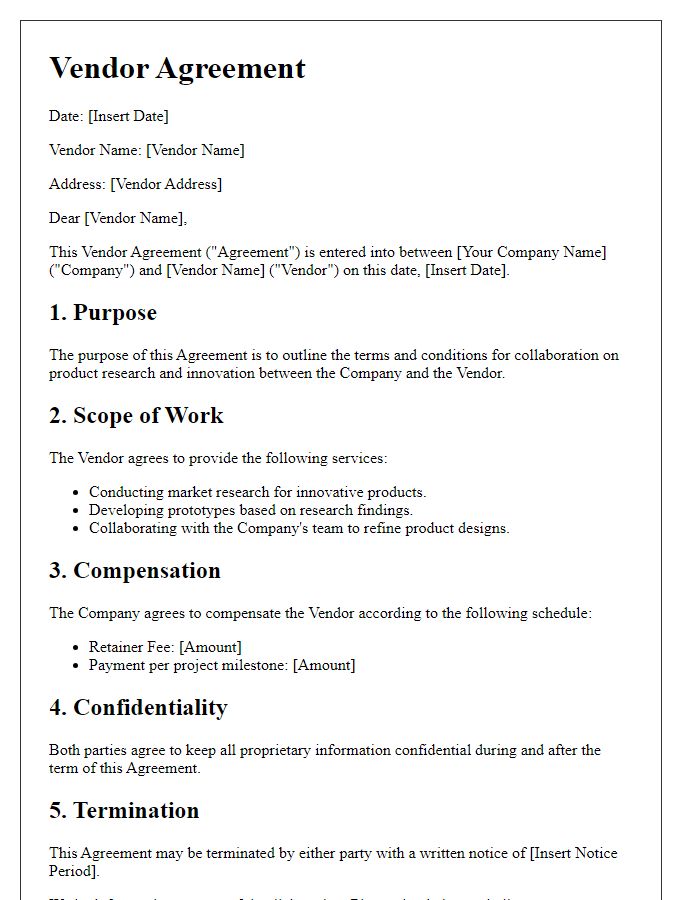Are you ready to take your product offerings to the next level? In today's rapidly evolving market, collaborating with the right vendors can spark innovative ideas and drive growth. This letter template serves as a foundation for establishing a vendor agreement focused on product innovation, ensuring that both parties align on objectives and expectations. Dive into the details and discover how you can foster a successful partnership that achieves remarkable results!

Introduction and Purpose
A vendor agreement for product innovation establishes a collaborative framework between companies focused on creating new or improved products. This document outlines objectives such as enhancing functionality, boosting market competitiveness, and driving technological advancements. The agreement details the roles of each party involved, including responsibilities for research and development, intellectual property rights (often referencing patented technologies), profit-sharing arrangements, and timelines for project milestones. By formalizing this partnership, both entities aim to leverage their strengths in innovation, ultimately leading to market-ready solutions that fulfill consumer demands in an efficient manner.
Scope of Innovation
Product innovation in vendor agreements focuses on the development of novel features or improvements to existing products, targeting increased efficiency and market competitiveness. This innovation may include advanced technologies such as artificial intelligence or machine learning, which enhance usability and performance. Additionally, the scope encompasses research and development activities in a collaborative environment, possibly at innovation hubs like Silicon Valley or tech incubators. The goal is to deliver cutting-edge solutions that meet evolving consumer demands while ensuring compliance with industry standards and regulations. Continuous feedback loops will facilitate iterative improvements, ensuring that all innovations remain aligned with market trends and customer needs. Key metrics for success will include reduced time to market, customer satisfaction rates, and product lifecycle enhancements.
Responsibilities and Deliverables
In a vendor agreement on product innovation, responsibilities and deliverables must be clearly defined to ensure mutual understanding between parties. The vendor, such as a technology supplier, is tasked with providing innovative solutions, including advanced prototypes or research findings related to products like smart home devices. The vendor must also deliver progress reports every month, highlighting milestones achieved and any challenges faced during development. Additionally, technical documentation outlining product specifications and compliance with industry standards must be submitted alongside prototypes. The client, often a manufacturing company, is responsible for timely feedback on prototypes and clear communication regarding product requirements. Both parties should establish a timeline, with deadlines indicating when specific deliverables, such as final product iterations, will be evaluated, typically every quarter. Ensuring these responsibilities are met will facilitate a smooth collaboration towards achieving innovation goals.
Intellectual Property Rights
Innovative partnerships can lead to significant advancements in product development, particularly in the realm of technology. A well-structured vendor agreement can establish clear terms regarding Intellectual Property Rights (IPR), crucial for protecting innovations developed collaboratively. Defining ownership of patents, trademarks, and copyrights is essential to prevent legal disputes. The agreement should specify procedures for filing patents, responsibilities for invention disclosures, and the management of confidential information, particularly in sectors such as software development or pharmaceuticals. Effective IPR management not only safeguards the interests of stakeholders but also enhances the commercial viability of new products in competitive markets. Additionally, outlining licensing terms can facilitate future collaborations and revenue-sharing opportunities.
Confidentiality and Non-Disclosure
Product innovation agreements often involve sensitive information shared between parties. A well-structured vendor agreement ensures that proprietary details remain protected. Essential elements include a confidentiality clause detailing the type of confidential information, such as trade secrets, business strategies, and technical specifications. The duration of the confidentiality obligation often spans several years (typically 3 to 5 years). Non-disclosure provisions should specify actions prohibited, such as sharing information with third parties or using the information for purposes outside the agreement. The agreement usually includes jurisdiction clauses, identifying the governing law, often linked to specific regions or states, like California or New York. Additionally, the document may require dispute resolution methods, including mediation or arbitration, to ensure any conflicts are handled efficiently without litigation.
Letter Template For Vendor Agreement On Product Innovation Samples
Letter template of vendor agreement for collaborative product innovation

Letter template of vendor agreement emphasizing product innovation collaboration

Letter template of vendor agreement for joint product enhancement initiatives

Letter template of vendor agreement focusing on innovative product solutions

Letter template of vendor agreement regarding breakthrough product innovation

Letter template of vendor agreement outlining product innovation partnership

Letter template of vendor agreement centered on product research and innovation

Letter template of vendor agreement for technology-driven product improvement






Comments